Pistol "Mannlicher" 1894 and its variants
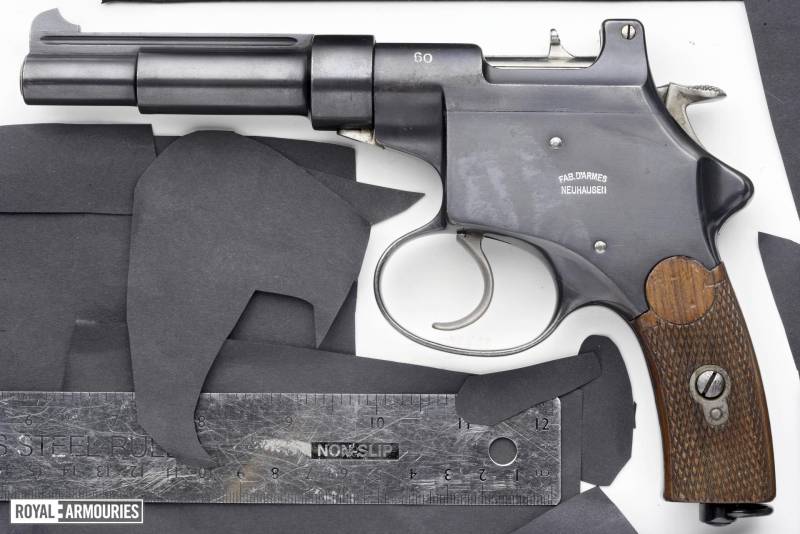
Mannlicher pistol 1894. Left view. Somewhat unusual in our opinion today turned out to be a pistol. But ... then there were many similar pistols to him (or he was like many other pistols of that time). Royal Arsenal, Leeds
produce mutual envy between people.
Book of Ecclesiastes or Preacher, 4:4
History firearms weapons. We continue our story about the first automatic pistols of the late nineteenth century, among which there were a lot of very original samples. That is, the trend was determined: the pistol had to be loaded by itself from the store arranged on it and shoot after each pull of the trigger. Of course, designers from different countries knew at that time about each other's work, although, perhaps, not in details. And, without a doubt, they were jealous of their more successful colleagues. And very often such envy was something like a horse's spurs. And at the same time - a powerful incentive to make your model better and more perfect. However, not always and not everyone succeeded.
For example, there was such a designer - Ferdinand Ritter von Mannlicher, born on January 30, 1848. He graduated from the Vienna University of Technology in 1869 and began working as an engineer for Austrian railway companies. At first, he did not do anything particularly outstanding.
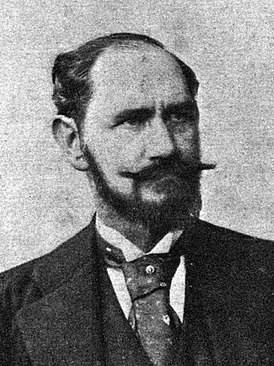
Ferdinand Ritter von Mannlicher (1848-1904)
But in 1875, Josef Werndl, also a well-known gunsmith and owner of his own business, invited Mannlicher to develop a magazine for his rifle. He completed the task quickly and efficiently, and in 1878 Werndl had already invited Mannlicher to his company "Österreichische Waffenfabrik AG" (OEWG) as a designer. And Mannlicher, until 1886, could not decide in any way - which is better, the railway industry or the arms business. But then I chose the latter! And - he became one of the outstanding designers-gunsmiths of his era - this is how a very capricious lady named Destiny disposed of him!
Among the many of his works, the pistol of the 1894 model occupies a special place. Before that, he was engaged in rifles, and then, having clearly received information about the work of his colleagues, in 1892 he decided to start creating a pistol. And already on December 6, 1893, he received an Austrian patent No. 44/4386 for its design, and a German patent No. 79090 a little later: December 12, 1893.
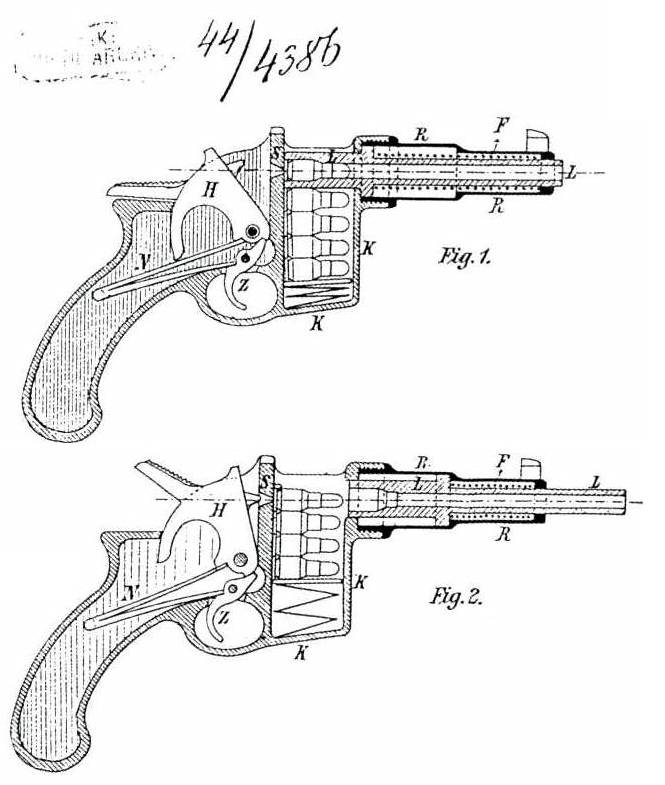
Diagram of the device of the Mannlicher pistol model 1893
The automation system that he chose was one of the most unusual in the world: it used the force of friction of a bullet against the rifling in the barrel. Like the Mauser, the pistol magazine was in front of the trigger guard. This pistol remained so experimental. But Mannlicher kept the automatic pistol and then used it in the pistol of 1894.
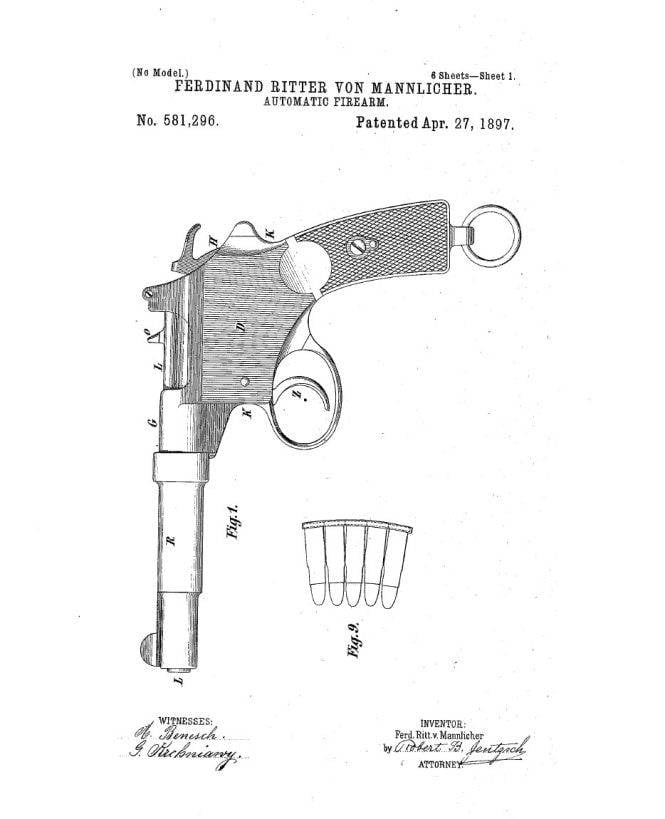
Drawing of a Mannlicher pistol from an American patent of 1897
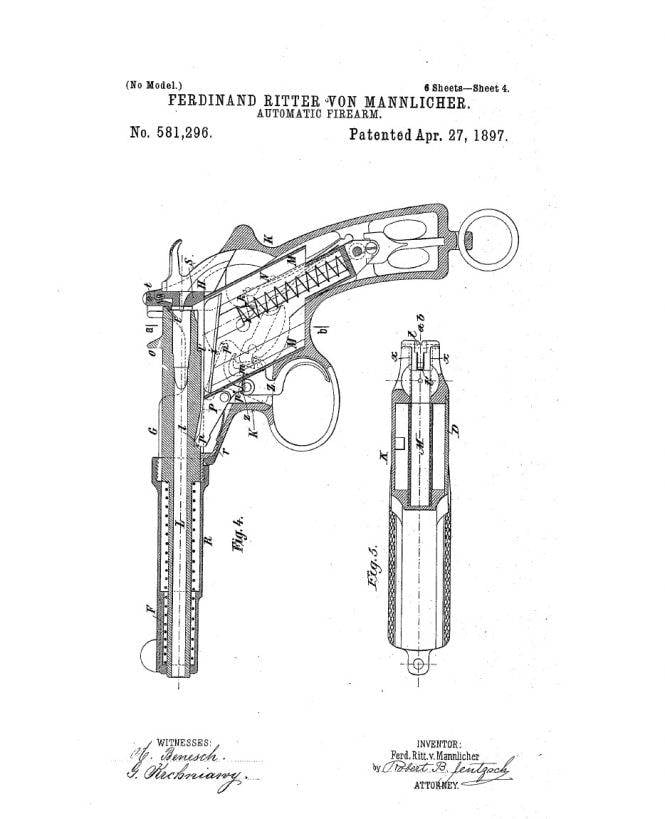
Drawing of a Mannlicher pistol from an American patent of 1897. Version with a single-row magazine for five rounds

Drawing of a Mannlicher pistol from an American patent of 1897. Option with a nine-round magazine
Ferdinand Mannlicher worked quickly and already on May 17, 1894 applied for a patent for a new pistol in several countries at once. He received patent No. 44/2911 in Austria on July 3, 1894, in Germany, patent No. 81020 was obtained on September 19, 1894, and in Hungary No. 4593, on November 24, 1895. Patents were obtained in France, Switzerland, Sweden, Great Britain, Italy, and then a patent in the United States under the number 581296 dated April 27, 1897, which was issued to a citizen of Austria-Hungary living in Vienna, Ferdinand Ritter von Mannlicher for an improved model of his pistol.
Now the magazine for five rounds was in the pistol grip. Moreover, in the graphic part of the patent, you can see that a two-row store was also proposed with an arrangement of nine cartridges in a checkerboard pattern. But this option was not implemented, as it increased both dimensions and weight. Moreover, in itself, this idea of Mannlicher turned out to be so innovative that the first pistols with such an arrangement of cartridges appeared in the store only four decades later!
It is clear that in the new Mannlicher pistol there were many traditional solutions. So, for example, its handle strongly resembled a revolver, including a ring located on it for attaching a belt. Ergonomics was not well thought out either. For example, due to the low location of the trigger guard, it was easier and more convenient for the shooter to press the trigger not with the index finger, but with the middle one. That is, the design of the pistol was not fully thought out.
But, of course, the most interesting thing about this pistol is its automation, the principle of which was used by only a very few gunsmiths. Its essence is that due to the friction force of the bullet on the rifling in the barrel, at the moment of the shot it moves forward, compressing the spring that is put on the barrel itself, and is covered from the outside with a casing on which the front sight is located. In this case, the sleeve is removed from the barrel and removed. As soon as the barrel reaches its extreme forward position, the force of the return spring begins to move it back and simply pushes it onto the next cartridge.
The designer needed to ensure the operation of the pistol mechanisms in such a way that the barrel would necessarily reach its extreme forward position, the sleeve was removed at the same time, and the bullet did not lose speed, and, of course, would not get stuck in the barrel bore.
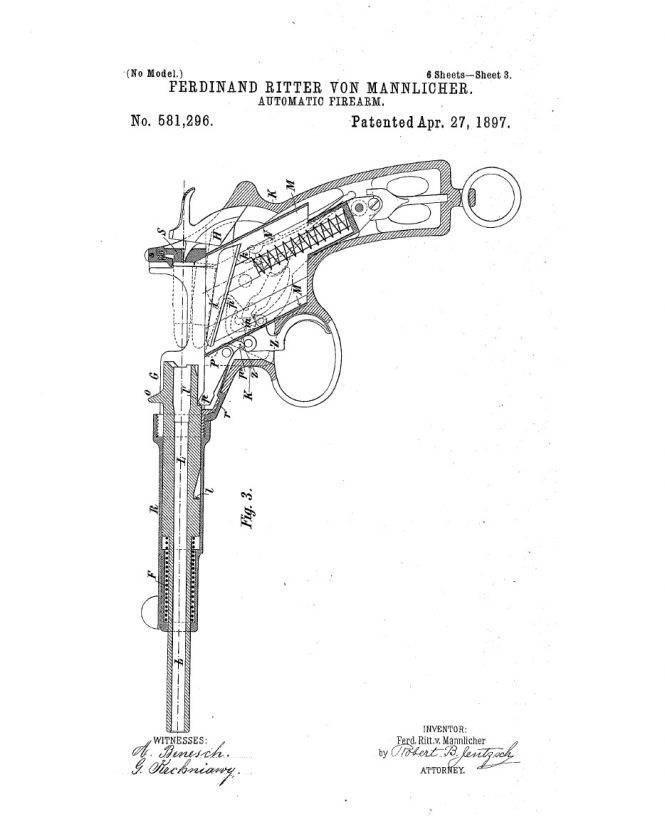
Scheme of the automatic operation of the M1894 pistol. Drawing from an American patent 1897
To cock the pistol and send the cartridge into the barrel, it was necessary to feed it forward, for which a notched protrusion was provided in its upper part above the chamber, by pressing which the barrel just moved to the extreme forward position. Then the finger should be removed from the protrusion, after which the barrel returned by the force of the spring to its original place and at the same time, as already noted, was simply pushed onto the next cartridge. It turned out that not every cartridge and not every bullet is suitable for such an automation system. So Mannlicher had to work hard, choosing a suitable cartridge and caliber, cartridges with 7,65-mm, 7,7-mm, 7,75-mm bullets were tested, as it turned out that even the thermal expansion of the barrel during firing affects the reliability of the automation. ...
The pistol magazine was loaded through the upper cutout in the pistol frame with the barrel open using special clips for five rounds, while the barrel was held in the forward position by pressing the trigger.
As for the trigger mechanism of the M1894 pistol, it was essentially its analogue, taken from double-action revolvers. That is, he had nothing to do with the automatics of the pistol, although he could work with self-cocking and with a preliminary cocking of the trigger. A hole for the hammer was made in the back of the frame. Interestingly, like the revolvers of the time, this pistol did not have a safety catch.
The pistol was named Halbautomatische Repetierpistole Sistem Mannlicher M1894 (semi-automatic reloading pistol with forward movement of the barrel and loading with a Mannlicher cartridge clip, Model 1894).
There were known pistols chambered for 6,5 mm and 7,5 mm - also Mannlicher's designs, like the pistol itself.
Initially, the Austrian company Steyr (Osterreichische Waffenfabriks-Gesellschaft, Steyr) was engaged in the manufacture of Mannlicher M1894 pistols. Early samples of the Mannlicher pistols of the 1894 model of the Steyr enterprise had an elongated hammer - the same as we see on the graphic part of the 1907 patent. In later models, the hammer spokes became shorter and wider.
As for the dimensions, the pistols of the first series had a length of 227 mm, a barrel - 186 mm, and a weight without cartridges of 989 grams. A total of only such pistols were produced ... 50. That is, only they were enough for tests and public demonstrations.
The first tests of the pistol were carried out back in 1895, after which the Austrian military ordered another 100 pistols for military tests, which were manufactured in 1896-1897. These pistols had a length of 228 mm, a barrel - 185 mm, and the weight without cartridges was exactly one kilogram.
The Swiss army also tested the Mannlicher M1894 pistol chambered for 6,5 mm. Their weight was less - 845 grams, with a total length of 220 mm and a barrel length of 170 mm.
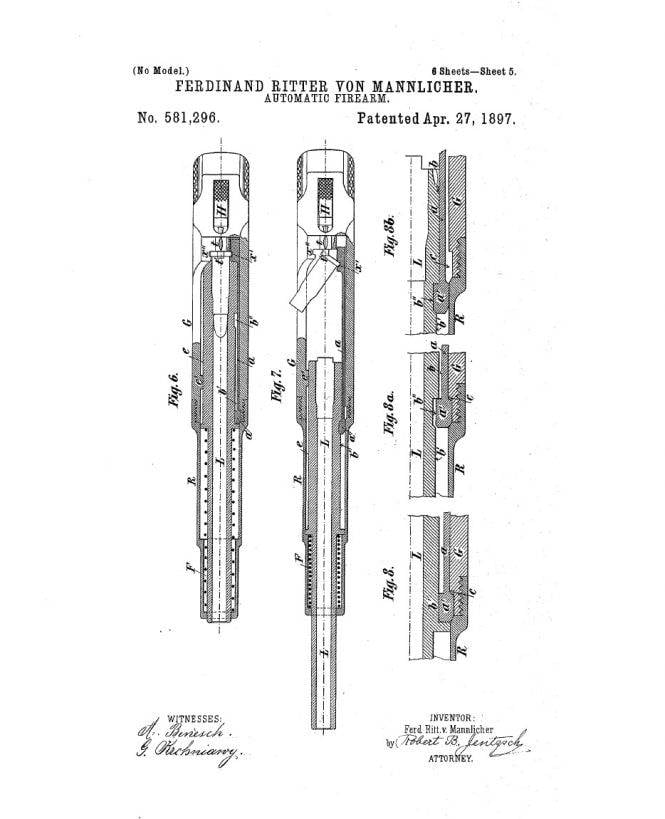
The scheme of action of the ejector, which on the M1894 pistol was placed on the left side of the barrel. When he moved forward, he lagged behind the barrel, grabbed the sleeve by the rim and threw it out of the pistol frame. Drawing from an American patent 1897
It is interesting that on some M1894 pistols, produced for Switzerland, on the back of the grip there were special projections with grooves to attach a holster-butt to the pistol.
Experts noted the following advantages of the Mannlicher M1894 pistol. First of all, the shooter's safety, since no parts when firing backward from the pistol do not move out and therefore cannot injure the shooter in any way. But on the other hand, during tests carried out in Austria, Switzerland, and the United States, it turned out that it was inconvenient to load it, the magazine capacity was small, and in addition, the cost of the pistol was too high compared to revolvers.
In total, about 230 Mannlicher M1894 pistols of the year 7,6 mm and 6,5 mm were produced, so today they are a collector's item. But it was not accepted for service anywhere!
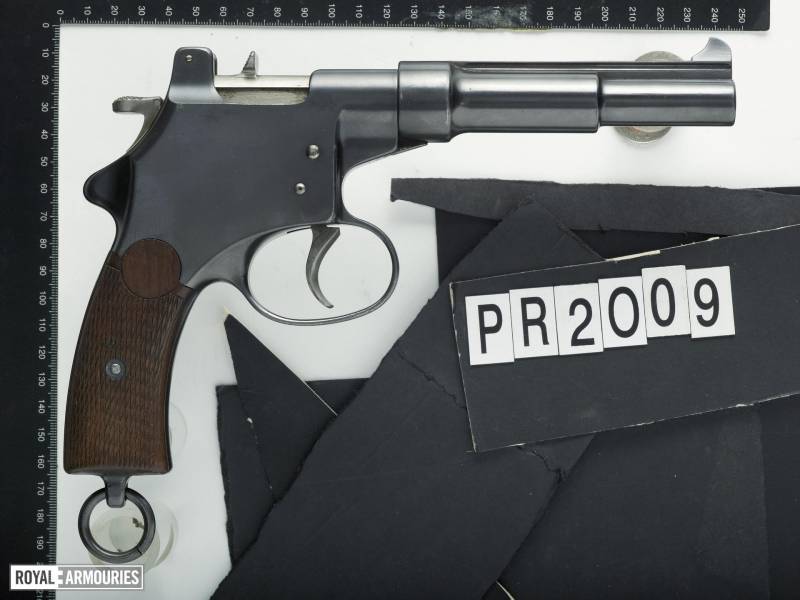
Information